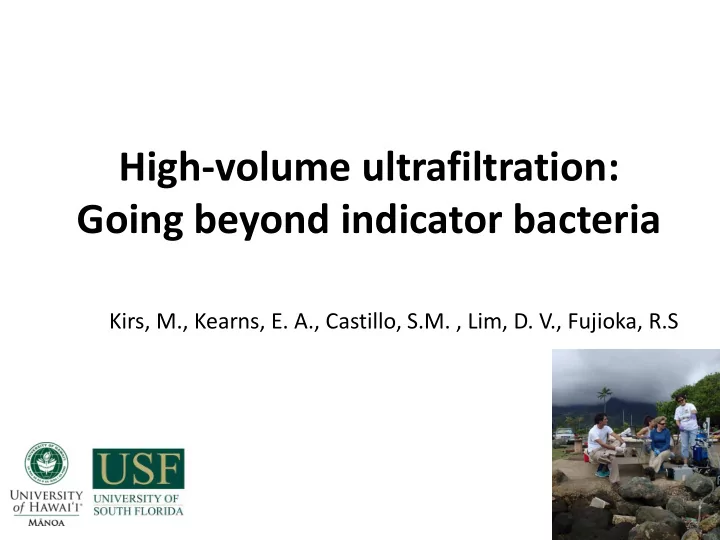

High-volume ultrafiltration: Going beyond indicator bacteria Kirs, M., Kearns, E. A., Castillo, S.M. , Lim, D. V., Fujioka, R.S
Outline • Introduction – Why water quality matters – HI Rules and Regulations • Issues with microbiological water quality measurements • Solution: ultrafiltration device – The device (PMACS) – Evaluation in HI • Conclusions and Future Directions
Why water quality matters? Human Health - water-borne illnesses Environment - biodiversity loss and decline of ecosystem services
Hawaii Rules and Regulations • Public ( drinking ) Water Systems (serve ≥ 15 connections or ≥ 25 individuals) HI DOH: HAR11:20, § 11 - 20 -6 Maximum Microbiological Contaminant Levels System is compliant when: 1) if n≥40 samples per month, ≤5% of samples positive for total coliforms if n<40 samples per month, ≤1 sample positive for total coliforms 2) No fecal coliforms OR Escherichia coli
Hawaii Rules and Regulations • Recreational Waters: DOH: HAR11:54, § 11 - 54 -8 Recreational criteria for all State waters Within 30 days: Enterococci : GM ≤ 35 CFU 100ml - 1 and STV 130 100ml - 1 (10% of samples). Warning signs shall be posted at locations where human sewage has been identified as temporarily contributing to the enterococcus count. Enterococcus and C. perfringens ≥50 CFU 100ml - 1 Roughly 4% or 7% samples exceed recreational water quality standards for enterococci in HI. HI ranked 7 out of 30 coastal states in US (NRDC, 2014)
Distribution of microorganisms is patchy Sources of pollutants (stream, sand, sediment, beach showers, swimmers, land runoff, etc.) Transport and dilution by tide and currents
Distribution of microorganisms is patchy in time Total Sample # coliforms E. coli Enterococci (5 min intervals) MPN/100ml MPN/100ml MPN/100ml 1 >24196 8164 5475 2 >24196 11199 4106 3 >24196 7270 3255 4 >24196 5794 2282 5 >24196 5794 4611 6 >24196 8664 4106 7 >24196 7701 2400 8 >24196 10462 2755 9 >24196 6488 2382 10 >24196 4352 3255 Arithmetic mean 7589 3463 Geometric mean 7317 3319 Standard deviation 2135 1079 Max 11199 5475 Min 4352 2282
Portable Multi-use Automated Concentration System (PMACS) (developed in the laboratory of Dr. Daniel Lim, University of South Florida) • Dead-end ultrafiltration device • Automated • Hollow fiber filter cartridges • 30 kDa • >100 L !!! • Light and portable Recovery module Collection module
Filte iltering ng sam ample le Dead-end flow Tangential flow Closed Hollow fibers Recirculation Filter membrane Permeate: light gray Test fluid: dark gray with black particles that are too big to pass filter membrane
Rec ecove overy Dead-end flow Tangential flow Closed Hollow fibers Recirculation Filter membrane Losing Buffer Backflush recovery: pushing buffer in direction opposite to test Laminar recovery: fluid flowing buffer in same direction as test fluid
Why Dead- end ultrafiltration (DEUF) • Easier to setup • Faster to filter • Simpler to automate • Consistent recovery (in HI: 363.2 ml ( ± 13.9 ml)) • Concentrates as well as TFUF
Hawaii Study Sewage Spike Beach Water Potable Water
Hawaii Study: Parameters • Fecal Indicator Bacteria (FIB): HPC, total coliforms, E. coli , enterococci, F + specific coliphage, C. perfringens • Source specific markers: human Bacteroides , human polyomaviruses
Hawaii Study Teams • Clean Water Branch, Hawaii Department of Health • City and County of Honolulu • WRRC, University of Hawaii • Dr. Daniel Lim Laboratory, University of South Florida
Hawaii Study: All Data Good agreement between estimates by both methods
Hawaii Study: Sewage spikes ** • Concentrations comparable by both methods • Enterococci, coliphages and human polyomaviruses were detected using ultrafiltration method only
Hawaii Study: Coastal Samples Group Grab Ultrafiltration 58.9% grab samples and sample sample 73.2 % ultrafiltration (%) (%) samples positive HPC 100 100 TC 100 100 ECOLI 86 100 - > Effective in retaining 28 ENT 57 100 nm sized particles CPERF 100 100 -> More representative PHAGE 0 29 sample HBAC 29 43 HPYV 0 29
- > Effective in retaining 28 nm sized particles -> More representative sample -> Good water quality on most beaches under ambient conditions
Hawaii Study: Potable water • Concentration of E. coli in two Honolulu source water samples analyzed was <0.001 MPN /100 ml (standard is <1MPN/100ml ) • No human specific markers Excellent microbiological source water quality
Take home message: Use wisely! Pros: • Provides representative sample • Excellent for detection of rare targets such as human pathogens • Can pick up 28 nm sized viral particles without prior treatment • Fully automated (consistent and little room for operator error) • Cost effective Cons: • Labor and time intensive <- but it has different purpose! • PCR inhibitors can be a challenge for molecular tests <- but can overcome! First instrument in Hawaii
Further projects • Coastal environments • Beach sand characterization • (Source water characterization) Utilized for: Pathogen detection, source specific markers, microbial community analyses
Source tracking in Kahalu`u Geometric mean of enterococci, C. perfringens and coliphages concentrations (from top down respectively) at each site (10 sites). Red, pink and green indicates human-associated Bacteroides , human polyomavirus and human adenoviruses as presence (+) in the samples collected (n=4 at each site, all samples were test ed). Percent of samples exceeding the enterococci based STV (130 cfu 100ml - 1 AND C. perfringens concentrations of 50 CFU 100 ml - 1 at each site are also indicated.
Source tracking in Manoa watershed
Several lanes of evidence
Workshop with the CWB (DOH)
Acknowledgments • Doak and Richard Cox Foundation • State WRRIP/USGS 104B • HI Department of Health Dr. Valerie J. Harwood (USF) • Mr. Owen Narikawa , Board of Water Supply • Mr. Watson Okubo, CWB, Department of Health • Mr. Ken Tenno, Lab. Branch, CCH •
Recommend
More recommend